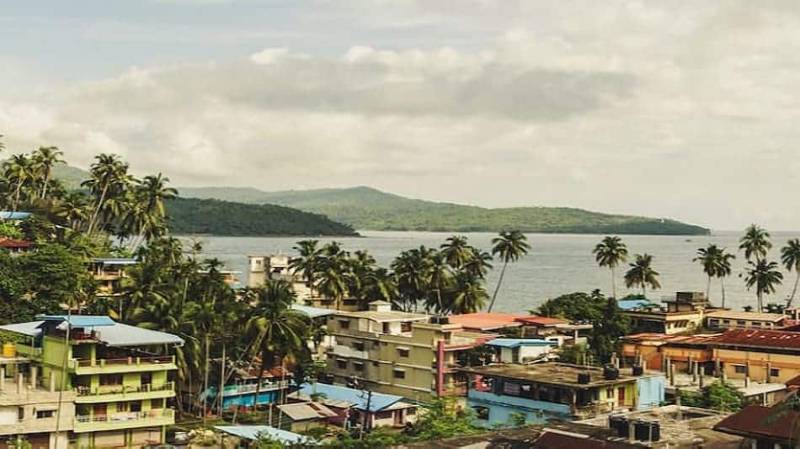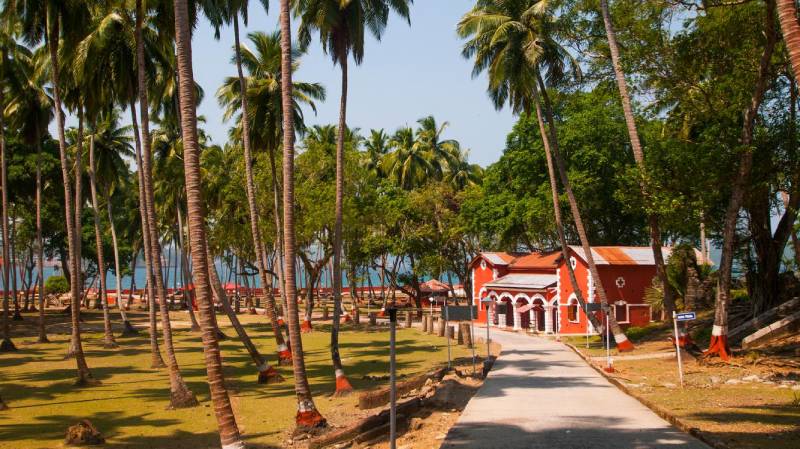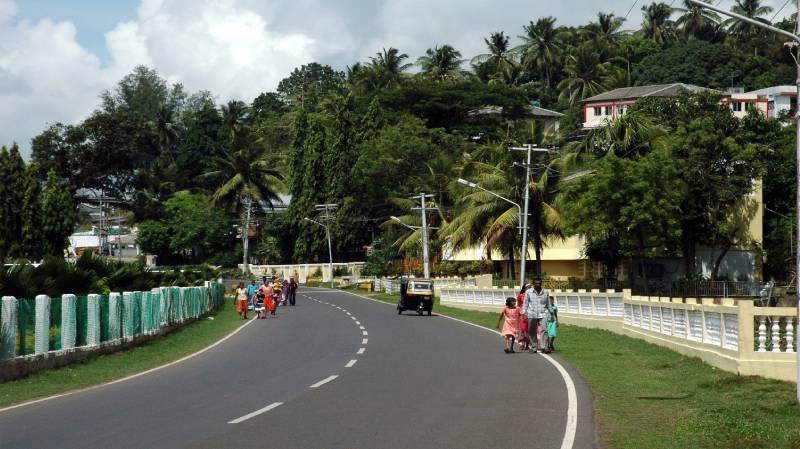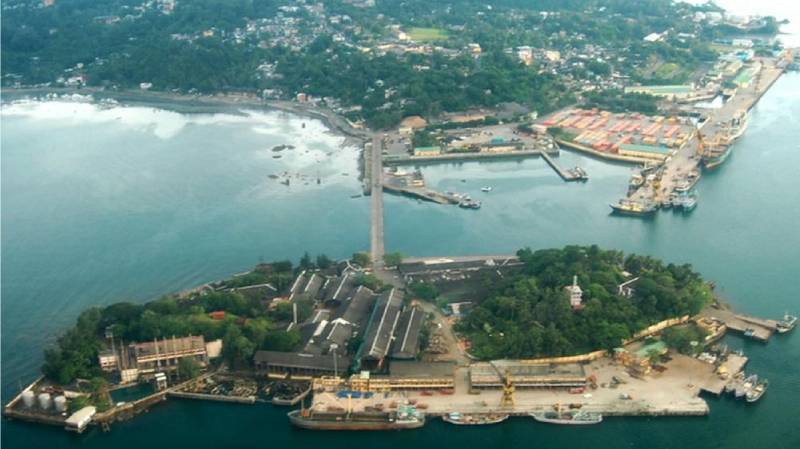Introduction to Port Blair
Port Blair is a captivating city situated in the Andaman and Nicobar Islands, a union territory of India. It is located in the Bay of Bengal, approximately 1,200 kilometers southeast of the mainland of India. Port Blair is nestled on the southern coast of South Andaman Island, surrounded by pristine blue waters and lush greenery.
Port Blair holds immense historical significance due to its connection with the colonial era and the Indian independence movement. The city served as a crucial naval base for the British during World War II and witnessed several important events during India's struggle for freedom. The Cellular Jail, a symbol of colonial oppression, stands as a testament to the sacrifices made by Indian freedom fighters who were imprisoned here.
Port Blair boasts a vibrant cultural diversity due to its amalgamation of different communities and indigenous tribes. The city is home to indigenous tribes such as the Jarawa, Onge, and Sentinelese, who have inhabited the islands for thousands of years, preserving their unique traditions and way of life. Additionally, Port Blair is populated by Tamil, Bengali, and Andhra communities, who have contributed to the cultural tapestry of the region through their customs, festivals, and cuisine.
The diverse cultural heritage of Port Blair creates a captivating blend of traditions and practices, offering visitors a unique experience of cultural immersion. The indigenous tribes showcase their ancient rituals, art forms, and traditional craftsmanship, providing insights into their rich cultural heritage. The Tamil, Bengali, and Andhra communities add their own flavors to the city's cultural landscape, organizing festivals and celebrations that reflect their respective customs and beliefs.
This cultural diversity is also evident in the culinary scene of Port Blair, with a wide array of dishes influenced by various regional cuisines. From delectable seafood delicacies to traditional South Indian, Bengali, and Andhra meals, the city offers a gastronomic journey that tantalizes the taste buds of locals and tourists alike.
Furthermore, the cultural diversity of Port Blair is celebrated through various cultural events and festivals. The Island Tourism Festival, held annually, showcases the traditional arts, music, and dance forms of the indigenous tribes and other communities. It provides a platform for artists to showcase their talents and promotes cultural exchange and harmony among different groups.

Historical Background of Port Blair
- Early Settlements and Indigenous Tribes
The history of Port Blair dates back to ancient times when the islands were inhabited by indigenous tribes. These tribes, such as the Jarawa, Onge, Sentinelese, and others, have lived in harmony with the islands' natural environment for thousands of years. They had their distinct languages, cultural practices, and close-knit communities.
- British Colonial Influence
The British East India Company established a settlement in Port Blair in 1789 to establish a strategic presence in the Bay of Bengal. Initially, the British used the islands as a penal colony for convicts and prisoners from the mainland. However, the British colonial influence expanded beyond the penal settlement, and Port Blair became an important administrative and commercial center.
- Cellular Jail and the Indian Independence Movement
One of the most significant chapters in the history of Port Blair is the construction and use of the Cellular Jail. The construction of this infamous jail began in 1896 and was completed in 1906. The Cellular Jail, also known as K?l? P?n? (Black Water), was a colonial prison built to hold Indian freedom fighters and political prisoners.
The Cellular Jail became synonymous with the suffering and sacrifices made by those who fought for India's independence. Many prominent freedom fighters, including Vinayak Damodar Savarkar, Batukeshwar Dutt, and Yogendra Shukla, were imprisoned in the Cellular Jail for their participation in the Indian independence movement. The prisoners endured brutal treatment, solitary confinement, and hard labor during their incarceration.
Despite the harsh conditions, the Cellular Jail became a hotbed of resistance and defiance. The inmates devised ways to communicate, educate each other, and plan for the freedom struggle. The jail played a significant role in fostering a sense of nationalism and unity among the prisoners.
The Indian independence movement gained momentum, and the struggle for freedom eventually led to India's independence in 1947. The Cellular Jail stands today as a national memorial, reminding visitors of the sacrifices made by countless individuals who fought for India's freedom.
The historical background of Port Blair, encompassing early settlements, British colonial influence, and the Cellular Jail's role in the Indian independence movement, highlights the city's deep-rooted history and its connection to the struggle for freedom. It is a testament to the resilience and determination of the people who fought against colonial oppression and played a crucial part in shaping the destiny of the nation.

Geographical Features of Port Blair
Port Blair is situated in the Andaman and Nicobar Islands, a group of islands in the Bay of Bengal. The region comprises approximately 572 islands, out of which only a few are inhabited. These islands offer a diverse range of landscapes, from lush green forests to pristine beaches and coral reefs.
The Andaman Islands, including South Andaman Island where Port Blair is located, are known for their scenic beauty and tranquility. The islands are characterized by their tropical forests, coconut groves, and breathtaking views of the ocean. Each island has its unique charm, with some offering adventurous activities like trekking and exploring caves, while others provide opportunities for relaxation and rejuvenation on secluded beaches.
Port Blair is renowned for its stunning beaches, with crystal-clear waters and white sandy shores. Corbyn's Cove Beach, located just a few kilometers from the city center, is a popular destination for both locals and tourists. Visitors can enjoy swimming, sunbathing, and indulging in water sports such as jet skiing and banana boat rides.
The region's marine life is incredibly diverse, attracting snorkelers and scuba divers from around the world. The clear waters surrounding Port Blair are home to vibrant coral reefs teeming with colorful fish, turtles, and other marine creatures. Popular diving spots like Mahatma Gandhi Marine National Park and Havelock Island offer a mesmerizing underwater experience with their rich biodiversity and coral formations.
- Biodiversity and Protected Areas
The Andaman and Nicobar Islands are recognized as one of the world's biodiversity hotspots. The region's isolation and unique geological history have led to the evolution of numerous endemic species found nowhere else on the planet. The islands are home to a remarkable array of flora and fauna, making it a paradise for nature enthusiasts and researchers.
Several protected areas have been established in and around Port Blair to safeguard the islands' rich biodiversity. One such area is the Mahatma Gandhi Marine National Park, located just a short boat ride away from Port Blair. The park encompasses a large marine area and a few islands, providing protection to coral reefs, mangroves, and endangered species like the dugong and the sea turtle.
Additionally, Mount Harriet National Park, located on the outskirts of Port Blair, offers a diverse range of flora and fauna, including various species of birds and butterflies. The park is a haven for nature lovers and hikers, with trails leading to stunning viewpoints overlooking the surrounding islands and the Bay of Bengal.
Efforts are being made to promote conservation and sustainable practices in the region. Eco-tourism initiatives are being encouraged, allowing visitors to explore the islands' natural wonders while minimizing their impact on the delicate ecosystems.

Tourism in Port Blair
Port Blair, the capital city of the Andaman and Nicobar Islands, is a vibrant tourist destination that offers a multitude of attractions and landmarks for visitors to explore and experience. Here are some of the prominent attractions in Port Blair:
Cellular Jail National Memorial: The Cellular Jail, also known as K?l? P?n?, is a historical landmark that stands as a poignant reminder of India's struggle for independence. This colonial-era jail, constructed in 1896, served as a prison for freedom fighters. Today, it has been transformed into a national memorial and museum that showcases the stories of the incarcerated heroes and the hardships they endured.
Ross Island: Once the administrative headquarters of the British, Ross Island now stands in ruins, offering a glimpse into its colonial past. Visitors can explore the remnants of British architecture, including the old church, ballroom, and residential quarters. The island's serene atmosphere and picturesque surroundings make it a captivating destination for history enthusiasts.
Anthropological Museum: The Anthropological Museum in Port Blair provides fascinating insights into the indigenous tribes of the Andaman and Nicobar Islands. It displays a wide range of tribal artifacts, tools, photographs, and models that depict the lifestyle, culture, and traditions of these tribes. The museum serves as a platform to understand and appreciate the rich cultural heritage of the region.
Corbyn's Cove Beach: Located just a few kilometers from Port Blair, Corbyn's Cove Beach is a popular spot for both tourists and locals alike. The beach boasts pristine white sand, swaying palm trees, and azure waters, making it an ideal place for relaxation and sunbathing. Visitors can indulge in water sports such as jet skiing and banana boat rides or simply enjoy a leisurely stroll along the shore.
Chidiya Tapu: Also known as the "Bird Island," Chidiya Tapu is a haven for birdwatchers and nature lovers. It is renowned for its diverse avian population and breathtaking sunset views. Visitors can spot a wide variety of bird species, including parakeets, sea eagles, and herons. The tranquil environment and lush greenery make it a perfect spot for picnics and nature walks.
Mahatma Gandhi Marine National Park: Situated near Wandoor Beach, the Mahatma Gandhi Marine National Park is a marine protected area that showcases the rich underwater biodiversity of the Andaman and Nicobar Islands. The park encompasses several islands and offers opportunities for snorkeling, scuba diving, and glass-bottom boat rides. Visitors can witness the vibrant coral reefs, colorful fishes, and other marine life that inhabit the area.
These attractions in Port Blair provide a blend of historical, cultural, and natural experiences, making it a captivating destination for tourists seeking to explore the beauty and heritage of the Andaman and Nicobar Islands.

Transportation and Connectivity
- Veer Savarkar International Airport: Veer Savarkar International Airport serves as the primary gateway to Port Blair and the Andaman and Nicobar Islands. Located approximately 2 km south of the city center, the airport provides domestic flights connecting Port Blair with major cities in India. Several airlines operate regular flights to and from destinations such as Chennai, Kolkata, and Delhi. The airport offers modern facilities and services to ensure a smooth travel experience for passengers. It plays a crucial role in facilitating tourism and business activities in the region, welcoming both domestic and international visitors to the enchanting islands of Andaman and Nicobar.
- Sea Connectivity: Ferry Services: Port Blair boasts a well-developed network of ferry services that connect the city with various islands in the Andaman and Nicobar archipelago. The ferry services provide a scenic and convenient mode of transportation, offering travelers the opportunity to explore the beautiful islands and experience the charm of the Andaman Sea. Regular ferry services operate to popular destinations like Havelock Island, Neil Island, Baratang Island, and Ross Island. The ferry terminals in Port Blair are equipped with facilities to assist passengers and ensure their safety and comfort during the journey. The availability of ferry services enhances the accessibility and connectivity of the region, enabling tourists to explore the diverse islands and enjoy their natural splendor.
- Local Transportation: Within Port Blair, there are various modes of local transportation that cater to the needs of residents and tourists alike. Buses are an affordable and commonly used means of getting around the city. The local bus network covers major areas and attractions within Port Blair, providing a convenient option for commuting. Taxis and auto-rickshaws are also readily available, offering a more personalized and flexible mode of transportation.
Additionally, many tourists choose to rent bikes or scooters to explore the city independently. Renting a two-wheeler provides the freedom to navigate through Port Blair's streets and discover its hidden gems at leisure. These diverse options for local transportation ensure that residents and visitors can easily move around the city, explore its attractions, and access essential services and facilities.
The future prospects of Port Blair are promising, with opportunities for sustainable tourism and economic growth. By preserving its natural beauty, historical landmarks, and diverse cultures, the city can continue to attract visitors and provide livelihoods for its residents. With responsible development and conservation efforts, Port Blair can ensure a prosperous future while maintaining the ecological and cultural integrity of the Andaman and Nicobar Islands.








